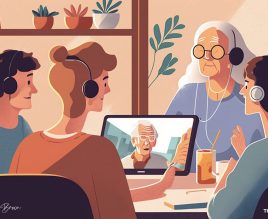Table of Contents
ToggleThe internet, often seen as a youth playground, is rapidly evolving into a universal haven. In this transformation, however, we must not overlook our older adults. They too must ride the digital wave. So, imagine this: what if our grandparents could effortlessly navigate digital spaces as we do? While some may view this as a distant dream, the reality might be closer than we think. Enter the realm of accessibility, human-centered design, and digital inclusion initiatives for older adults.
The importance of digital accessibility for seniors cannot be understated. It is, quite literally, a lifeline that bridges the gap between social isolation and connectivity. But that’s only part of the equation. Human-centered design takes us a step further. It creates digital spaces that not only are accessible but also intuitive and enjoyable for seniors to use.
Digital Accessibility for Older Adults

Digital accessibility is crucial for older adults as technology becomes a fundamental part of daily life. It involves making digital platforms, tools, and resources user-friendly for seniors, considering factors like vision, hearing, mobility, and cognitive abilities.
Implementing larger, easy-to-read text, clear navigation options, and voice assistance are some measures to improve accessibility. Training programs designed to enhance digital literacy among older adults are also essential. These initiatives promote inclusion, allowing seniors to fully participate in the digital world, whether it’s accessing information, using online services, or staying connected with loved ones.
Understanding Digital Accessibility and Its Importance
Digital accessibility refers to the practice of creating digital content, platforms, and technologies that are usable by all people, regardless of their abilities or disabilities. Think of it as removing barriers that can prevent interaction with, or access to, digital services by individuals with disabilities, including older adults.
As seniors confront issues such as reduced vision, hearing loss, decreased fine motor skills, and cognitive changes, they may find using digital platforms a daunting task. But it doesn’t have to be this way. With digital accessibility, we can tailor the digital universe to accommodate the needs and capabilities of these users.
Consider this. What if your favorite social media platform introduced an accessible interface tailored to seniors? It could include large fonts, straightforward navigation, and voice commands, promoting user-friendly interactions. An accessible digital space would turn a frustrating experience into a smooth, enjoyable one for older adults.
The importance of digital accessibility is two-fold. On a societal level, it promotes inclusivity and equality. On a personal level, it boosts the quality of life for seniors, providing them with independence and a sense of belonging in today’s digital society. In short, digital accessibility is about creating a world where age doesn’t limit one’s ability to participate in the digital realm.
Best Practices for Designing Accessible Digital Experiences

Designing for digital accessibility requires foresight, empathy, and a thorough understanding of the user’s needs. It’s about building digital spaces from the ground up with accessibility in mind.
- Consistent and intuitive navigation: Consistency is crucial. Whether it’s the layout, color scheme, or navigation. Keep it consistent across your digital platform. This minimizes confusion and reduces the learning curve for seniors.
- Readable content: Ensure your content is easily readable. Use large font sizes, high contrast colors, and avoid clutter. Moreover, break content into smaller sections to make it more digestible.
- Alt-text for images: Always include descriptive alt-text for images. This aids seniors who use screen readers, as it describes the content of the image, ensuring they don’t miss out on important information.
- Accessible forms: Forms can be tricky for older adults to navigate. Hence, use clear labels, provide error messages, and offer help text to assist them in successfully completing the forms.
- Captions and transcripts: Always provide captions for videos and transcripts for audio content. This makes your content accessible to seniors with hearing impairments.
Human-Centered Design for Seniors
Now that we’ve unraveled the intricacies of digital accessibility, let’s dive into the world of human-centered design. This empathetic approach reshapes technology to fit human needs rather than forcing humans to adapt to technology.
Principles of Human-Centered Design
Human-centered design is a creative approach to problem-solving that starts with understanding the people you’re designing for and ends with tailor-made solutions for them. It’s more than a methodology; it’s a mindset that prioritizes the human experience above all. Three guiding principles underpin human-centered design:
- Empathy for the user: This principle involves understanding the users, their needs, aspirations, and the context of their lives. It means stepping into the user’s shoes and viewing the world from their perspective.
- Ideate, prototype, and test: Human-centered design is a cyclical process that includes generating ideas, creating prototypes, testing them, and refining based on feedback. It’s an ongoing dialogue between the designer and the user, where solutions are continually optimized.
- Ideate, prototype, and test: Users aren’t just passive recipients of solutions. In human-centered design, they’re active participants in creating solutions. This approach recognizes the invaluable insights users bring to the table, leading to solutions that truly resonate with them.
Implementing Human-Centered Design in Digital Spaces for Older Adults
Harnessing human-centered design for seniors’ digital spaces requires understanding, empathy, and innovation. By blending these elements, we can create intuitive, accessible platforms. This is our strategy to bring this vision to life. Here’s how we can make it happen:
- Understand the user: Understanding older adults goes beyond knowing their physical and cognitive abilities. It’s about appreciating their experiences, attitudes towards technology, motivations, and fears. For example, seniors might be hesitant to use online banking due to fear of cyber fraud. Designing with empathy involves addressing this fear, ensuring security measures are clearly communicated and simple to use.
- Prototyping and testing: When it comes to testing, patience is key. Older adults may take longer to understand and navigate new interfaces. Thus, conduct tests in a relaxed, unhurried environment. Encourage honest feedback, and make your users comfortable with the fact that it’s the design being tested, not them.
- Co-creating with older adults: Involve older adults in the design process. Their insights can lead to surprising revelations, like preferring a longer, comprehensive guide over “quick start” instructions, or prioritizing a human voice in customer service over chatbots.
Human-Centered Design for Seniors
Now that we’ve unraveled the intricacies of digital accessibility, let’s dive into the world of human-centered design. This empathetic approach reshapes technology to fit human needs rather than forcing humans to adapt to technology.

Principles of Human-Centered Design
Human-centered design is a creative approach to problem-solving that starts with understanding the people you’re designing for and ends with tailor-made solutions for them. It’s more than a methodology; it’s a mindset that prioritizes the human experience above all.
Three guiding principles underpin human-centered design:
- Empathy for the user: This principle involves understanding the users, their needs, aspirations, and the context of their lives. It means stepping into the user’s shoes and viewing the world from their perspective.
- Ideate, prototype, and test: Human-centered design is a cyclical process that includes generating ideas, creating prototypes, testing them, and refining based on feedback. It’s an ongoing dialogue between the designer and the user, where solutions are continually optimized.
- Co-creation with users: Users aren’t just passive recipients of solutions. In human-centered design, they’re active participants in creating solutions. This approach recognizes the invaluable insights users bring to the table, leading to solutions that truly resonate with them.
Implementing Human-Centered Design in Digital Spaces for Older Adults
Applying human-centered design to digital spaces for seniors is an art that requires understanding, empathy, and innovation. Each of these factors is important for a smooth human-centered design. Here’s how we can make it happen:
- Understand the user: Understanding older adults goes beyond knowing their physical and cognitive abilities. It’s about appreciating their experiences, attitudes towards technology, motivations, and fears. For example, seniors might be hesitant to use online banking due to fear of cyber fraud. Designing with empathy involves addressing this fear, ensuring security measures are clearly communicated and simple to use.
- Prototyping and testing: When it comes to testing, patience is key. Older adults may take longer to understand and navigate new interfaces. Thus, conduct tests in a relaxed, unhurried environment. Encourage honest feedback, and make your users comfortable with the fact that it’s the design being tested, not them.
- Co-creating with older adults: Involve older adults in the design process. Their insights can lead to surprising revelations, like preferring a longer, comprehensive guide over “quick start” instructions, or prioritizing a human voice in customer service over chatbots.
Real-Life Examples and Anecdotes
To bring our discussion to life, let’s delve into some real-world examples and anecdotes that highlight the impact of accessible digital services, human-centered design, and community-based digital inclusion initiatives on older adults’ lives.
A Senior’s Experience with Accessible Digital Services
Meet Marjorie, an 82-year-old retiree living in New York City. Marjorie, like many of her peers, faced challenges when first navigating the digital world. Small text, complex navigation, and unclear instructions made her online experiences frustrating.
However, her world changed when her bank introduced a new, accessible interface. The app featured large, clear fonts, straightforward navigation, and personalized voice commands. Now, Marjorie could perform transactions with ease, checking her account balance, paying bills, or transferring money without needing help.
Marjorie’s story illuminates the power of accessible digital services. It shows how catering to older adults’ needs can transform their digital experiences, empowering them with the independence they deserve.
How Human-Centered Design Improved an Older Adult’s Digital Experience
Consider John, a 76-year-old from London. John loved to connect with his family scattered across the globe, but found the popular social media platforms overwhelming and confusing. A local tech company, hearing stories like John’s, decided to create a social media app designed specifically with seniors in mind. Through a human-centered design process, they created a simple, intuitive interface.
They also provided a comprehensive guide, allowing users like John to slowly but surely navigate the platform. Now, John eagerly checks his app daily, sharing photos and messages with his family. This example demonstrates how human-centered design, when executed thoughtfully, can significantly improve older adults’ digital experiences.
A Community-Based Digital Inclusion Initiative for Seniors
Let’s travel to Tokyo, where a unique community-based digital inclusion initiative is making waves. Here, a group of tech-savvy young volunteers called the “Tech Pals” help seniors navigate the digital world. Yuki, an 85-year-old resident, was initially hesitant to use her tablet, fearing she would break it or get lost online.
But when she met her Tech Pal, Ayumi, her fears began to melt away. With Ayumi’s patient guidance, Yuki learned to send emails, video call her grandkids, and even started an online origami club. This anecdote exemplifies how community-based initiatives can not only teach seniors digital skills but also foster relationships between generations.
Implications and Future Developments
As we delve deeper into the digital age, the concepts of accessibility and inclusion take on even greater significance. Let’s examine the implications of these trends and contemplate the future developments we might see.
The Growing Importance of Inclusive Digital Spaces for an Aging Population
The world’s population is aging, with the number of people aged 60 and above expected to double by 2050. As such, the importance of building inclusive digital spaces will continue to grow. The digital realm offers older adults a world of opportunities, from accessing information and services to maintaining social connections and engaging in hobbies. But to realize this potential, we must ensure these spaces are accessible to them.
If seniors can’t use digital technologies effectively, they risk being marginalized, missing out on critical services, and experiencing social isolation. Conversely, if we successfully build inclusive digital spaces, we can enhance seniors’ quality of life, empower them with independence, and foster their continuous engagement in society. The stakes are high, and the responsibility is ours to ensure that older adults can navigate the digital world confidently and comfortably.
Emerging Technologies and Trends in Digital Accessibility and Inclusion
As technology continues to advance, exciting possibilities emerge for enhancing digital accessibility and inclusion. Artificial intelligence (AI), for instance, offers promising applications. AI can power adaptive interfaces that learn from each user’s behavior, adjusting display settings or navigation patterns to suit individual needs. Voice-activated assistants, like Alexa or Google Home, are already assisting seniors with tasks and offering companionship, demonstrating a glimpse of AI’s potential. Augmented and virtual reality (AR/VR) technologies could offer immersive, intuitive ways for seniors to interact with digital content. From virtual social gatherings to VR-guided exercise routines, these technologies could transform the digital experience for older adults.
Moreover, the trend towards community-based digital literacy programs is expected to continue, further bridging the digital divide. These programs can address local needs effectively, foster intergenerational relationships, and build digital confidence among seniors. While these emerging technologies offer thrilling prospects, they also underscore the importance of keeping human-centered design principles at the forefront. As we forge ahead into this digital future, let’s ensure that it’s one where everyone feels at home.
Conclusion
As we conclude this exploration into building inclusive digital spaces for older adults, several key insights emerge. The importance of digital accessibility and human-centered design stands out, underlining the need for technology that accommodates the unique needs of seniors. We’ve also seen how digital inclusion initiatives, whether led by public or private sectors, can significantly improve the digital experiences of older adults.
We’ve learned from the stories of Marjorie, John, and Yuki that when technology is made accessible and intuitive, it can transform the lives of seniors. It empowers them with independence, keeps them connected with their loved ones, and opens up a world of opportunities for them to explore.
Moving forward, the task is clear but not easy. As our global population ages, the need for inclusive digital spaces will continue to grow. Meanwhile, emerging technologies offer new possibilities for enhancing digital accessibility and inclusion. Our commitment must be ongoing. It’s not merely about building inclusive digital spaces but about continuously refining and reinventing them. The goal is a digital world where everyone, regardless of their age, can navigate with ease, confidence, and joy.
FAQs
What does digital accessibility mean for older adults?
Digital accessibility for older adults means ensuring digital spaces are easily usable and navigable for them. It involves considering their unique needs like larger fonts, clear instructions, simpler navigation, and compatibility with assistive devices like screen readers or speech recognition software.
How can human-centered design benefit seniors in digital spaces?
Human-centered design involves creating digital spaces based on the specific needs and preferences of users, including seniors. It can result in intuitive, straightforward interfaces that are easy for older adults to navigate, thus reducing barriers to digital engagement and enhancing their overall online experience.
What are some examples of successful digital inclusion initiatives for older adults?
Examples include the U.S.-based Aging Connected initiative, Australia’s Tech Savvy Seniors program, and Spain’s ‘Silver Click’ project. These programs promote digital literacy, provide affordable devices and internet access, and foster intergenerational relationships, thereby promoting digital inclusion among older adults.
How can organizations ensure their digital services are accessible to seniors?
Organizations can adopt accessibility standards, implement human-centered design principles, and engage with seniors in the design process. Offering alternative methods of interaction, like voice commands or touch interfaces, and including clear instructions can also ensure their digital services are accessible to seniors.
What role do governments play in promoting digital inclusion for older adults?
Governments play a crucial role by formulating and enforcing policies that promote digital inclusion. They can mandate accessible web design, provide funding for digital literacy programs, and invest in infrastructure to ensure internet access for all, including seniors.
Are there any challenges in creating inclusive digital spaces for seniors?
Challenges include addressing a diverse range of abilities and comfort levels with technology among older adults, overcoming financial barriers to access, and keeping up with rapid technological changes. It requires continuous efforts and collaboration between governments, tech companies, and communities to create and maintain inclusive digital spaces for seniors.
Reference
- https://www.ncbi.nlm.nih.gov/
- https://www.w3.org/
- https://uxplanet.org/

















